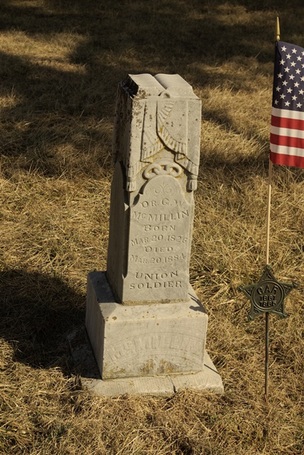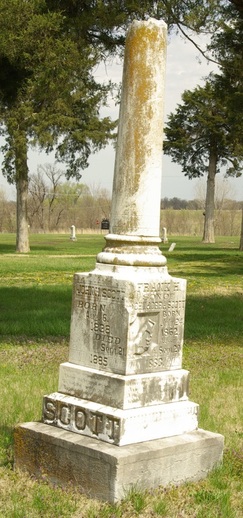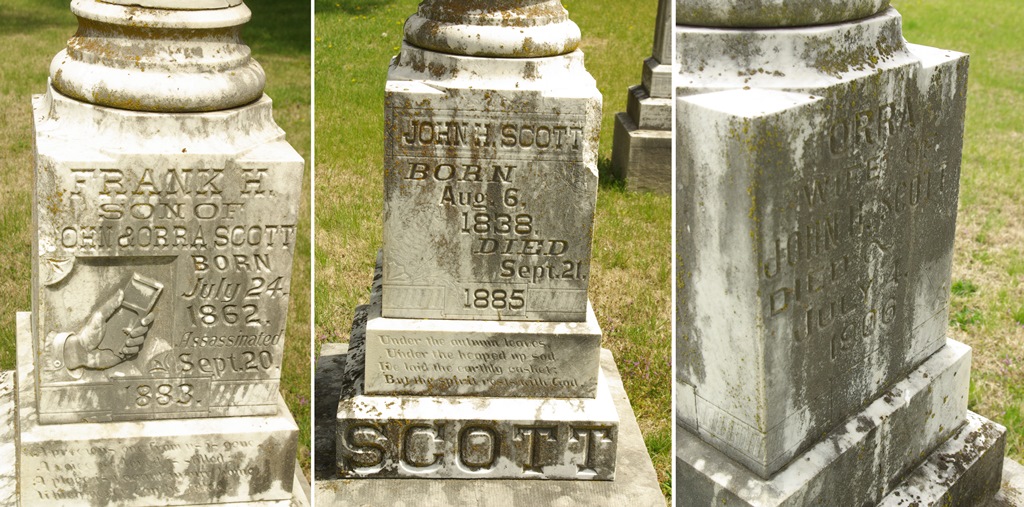Hope Cemetery
While Hope Cemetery is smaller than St. Francis Catholic Cemetery many of the the grave markers within it could also tell stories about the frontier period. Two stories, one tragic, reflect local events during the late 19th century.
While Hope Cemetery is smaller than St. Francis Catholic Cemetery many of the the grave markers within it could also tell stories about the frontier period. Two stories, one tragic, reflect local events during the late 19th century.
St. Francis Catholic Cemetery, located 1/4 mile east of St. Francis Catholic Church in St. Paul, was just that—a Catholic Cemetery. As settlers moved into our area many were of Protestant faiths. As harsh as it sounds today, Protestant settlers were not allowed to be buried in St. Francis Cemetery. For a few years settlers were buried in small cemeteries scattered around the area or at family homes. In 1874, Hope Cemetery was established one mile north of St. Francis Catholic Church. Over time, many graves were relocated from smaller graveyards or home plots. However, it is believed that several unmarked graves still exist within the city limits of St. Paul.
Hope, like St. Francis Cemetery, is still active and well maintained. It also contains the graves of many settlers, Civil War veterans and prominent people. Two stories, related to markers within Hope, are relayed here because they talk about the times; and they point out that Osage Mission was indeed a frontier town.
Hope, like St. Francis Cemetery, is still active and well maintained. It also contains the graves of many settlers, Civil War veterans and prominent people. Two stories, related to markers within Hope, are relayed here because they talk about the times; and they point out that Osage Mission was indeed a frontier town.

Dr. George W. McMillin.
There is a long-running rumor that a doctor who attended to President Lincoln, on the evening of his assassination, is buried in Hope Cemetery. Based on research done by the local museum and myself, it is probably true. However, Doctor George McMillin’s importance to the local settlers might have exceeded his part in treating President Lincoln.
By the time Dr. McMillin arrived at Osage Mission in 1869 he had distinguished himself as a physician, a U.S. Cavalry surgeon and contract surgeon-in-charge of the United States General Hospital in Ashland, Kentucky. Upon his arrival at the Mission Dr. McMillin served the community and settlers with a passion similar to his previous duties. As a leading figure in the Settler's League he spent heavily from his private fortune to gain a favorable resolution to an attempt by the railroads to gain possession of settler's property. His local legacy is loyalty to our ancestors.
But it was an event on the evening of April 14, 1865 that secured a spot in history for Dr. McMillin. He was among a group of military officers and surgeons in the audience the evening of President Lincoln's assassination. According to Dr. McMillin's obituary in the March 26, 1884 Neosho County Journal: "...the doctor sprang to a column, up which by the help of some of the officers, he clambered into the box where the president lay, being the first surgeon there, and at once saw and pronounced the wound to be mortal: and then assisted in removing the sufferer from the scene of his martyrdom." (He passed on March 20.)
There is dispute as to whether it was Dr. McMillin or Army Surgeon Dr. Charles Leale who initially pronounced the wound as fatal. However, research has confirmed that McMillin did arrive at Camp Stoneman (Washington D.C.) approximately four weeks prior to the assassination. His stature as an officer and surgeon makes it likely that he would have been among the doctors present at Ford Theater on that evening. By all accounts, both McMillin and Leale were only two among a group of surgeons present at the time of Lincolns death. (See the "... Reference Information:" section below for a published article about the assassination.)
Doctor McMillin’s stone is about seventy feet north, northwest of the central flagpole.
There is a long-running rumor that a doctor who attended to President Lincoln, on the evening of his assassination, is buried in Hope Cemetery. Based on research done by the local museum and myself, it is probably true. However, Doctor George McMillin’s importance to the local settlers might have exceeded his part in treating President Lincoln.
By the time Dr. McMillin arrived at Osage Mission in 1869 he had distinguished himself as a physician, a U.S. Cavalry surgeon and contract surgeon-in-charge of the United States General Hospital in Ashland, Kentucky. Upon his arrival at the Mission Dr. McMillin served the community and settlers with a passion similar to his previous duties. As a leading figure in the Settler's League he spent heavily from his private fortune to gain a favorable resolution to an attempt by the railroads to gain possession of settler's property. His local legacy is loyalty to our ancestors.
But it was an event on the evening of April 14, 1865 that secured a spot in history for Dr. McMillin. He was among a group of military officers and surgeons in the audience the evening of President Lincoln's assassination. According to Dr. McMillin's obituary in the March 26, 1884 Neosho County Journal: "...the doctor sprang to a column, up which by the help of some of the officers, he clambered into the box where the president lay, being the first surgeon there, and at once saw and pronounced the wound to be mortal: and then assisted in removing the sufferer from the scene of his martyrdom." (He passed on March 20.)
There is dispute as to whether it was Dr. McMillin or Army Surgeon Dr. Charles Leale who initially pronounced the wound as fatal. However, research has confirmed that McMillin did arrive at Camp Stoneman (Washington D.C.) approximately four weeks prior to the assassination. His stature as an officer and surgeon makes it likely that he would have been among the doctors present at Ford Theater on that evening. By all accounts, both McMillin and Leale were only two among a group of surgeons present at the time of Lincolns death. (See the "... Reference Information:" section below for a published article about the assassination.)
Doctor McMillin’s stone is about seventy feet north, northwest of the central flagpole.
Go to: St. Francis Cemetery Catholic Cemetery - or - Places
Some Reference Information:
- Hope Cemetery Records, Main Volume, compiled by George M. Paine (This is the main volume that was published in 2001. Mr. Paine and his wife have kept the records up to date with the addition of three addendum's to date.)
- Neosho County Newspapers, W. W. Graves, 1938 (Frank Scott's work with the Osage Mission Journal)
- The information regarding Dr. McMillin's stationing at Camp Stoneman (Washington D.C.) was found on a Civil War website that has been discontinued. There are brief mentions of Dr. McMillin (or McMillan) as a surgeon or Colonel at other sources.
- In 1925 The Spanish American Institute Press reprinted a Daily Morning Chronicle (Washington D. C.) article about the assassination of President Lincoln. The document was published in a pamphlet format. Page 11 of the document mentions both Doctors McMillin (spelled McMillan) and Leale as being among the attending physicians at the Peterson house where the president died (Page 15 on Scribd viewer). The document is provided below. This document is available from various internet sources including the Hathi Trust Digital Library and The Lincoln Financial Foundation Trust Collection.
- All photos were taken by R. Brogan.


